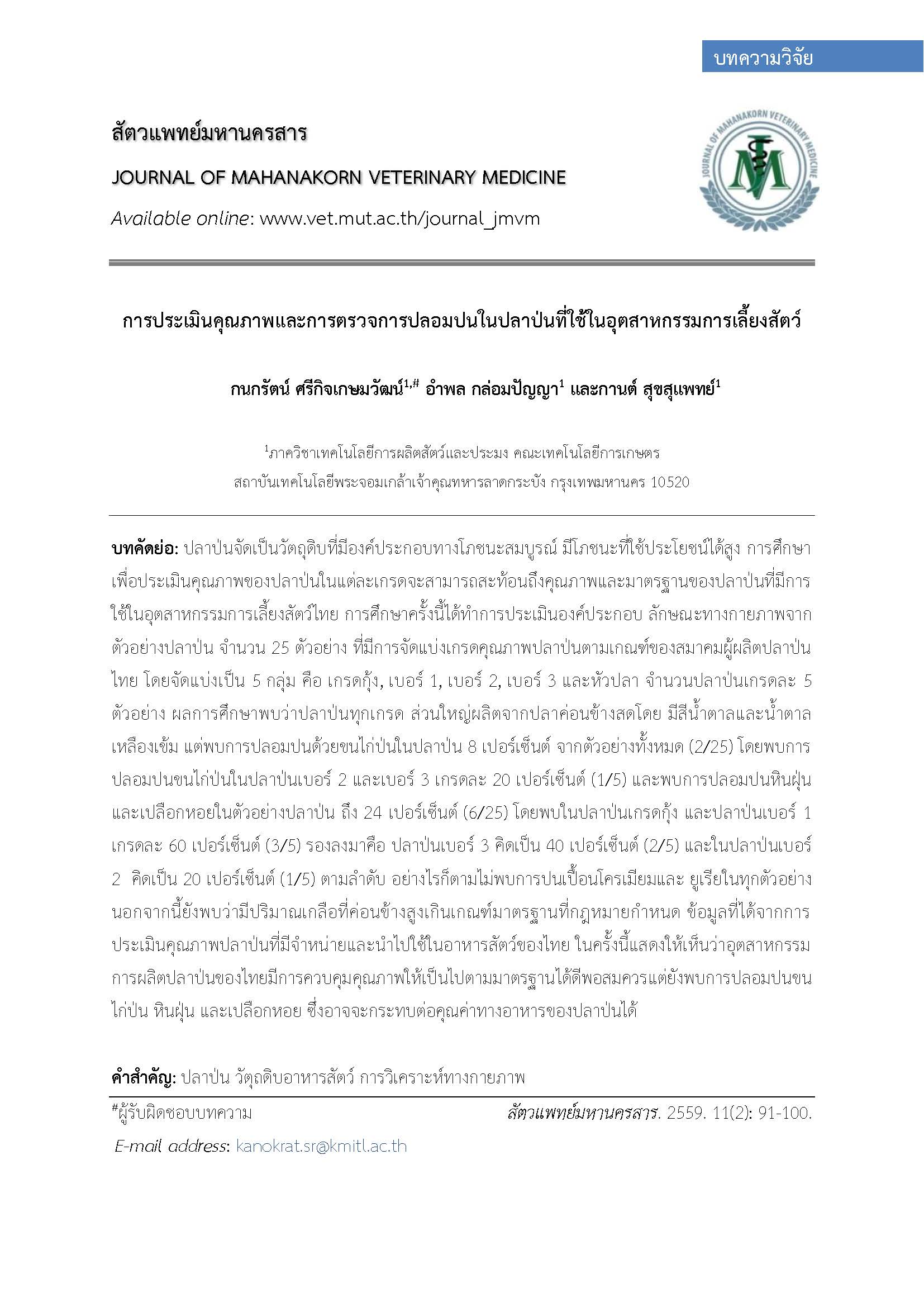การประเมินคุณภาพและการตรวจการปลอมปนในปลาป่นที่ใช้ในอุตสาหกรรมการเลี้ยงสัตว์
Main Article Content
บทคัดย่อ
ปลาป่นจัดเป็นวัตถุดิบที่มีองค์ประกอบทางโภชนะสมบูรณ์ มีโภชนะที่ใช้ประโยชน์ได้สูง การศึกษาเพื่อประเมินคุณภาพของปลาป่นในแต่ละเกรดจะสามารถสะท้อนถึงคุณภาพและมาตรฐานของปลาป่นที่มีการใช้ในอุตสาหกรรมการเลี้ยงสัตว์ไทย การศึกษาครั้งนี้ได้ทำการประเมินองค์ประกอบ ลักษณะทางกายภาพจากตัวอย่างปลาป่น จำนวน 25 ตัวอย่าง ที่มีการจัดแบ่งเกรดคุณภาพปลาป่นตามเกณฑ์ของสมาคมผู้ผลิตปลาป่นไทย โดยจัดแบ่งเป็น 5 กลุ่ม คือ เกรดกุ้ง, เบอร์ 1, เบอร์ 2, เบอร์ 3 และหัวปลา จำนวนปลาป่นเกรดละ 5 ตัวอย่าง ผลการศึกษาพบว่าปลาป่นทุกเกรด ส่วนใหญ่ผลิตจากปลาค่อนข้างสดโดย มีสีน้ำตาลและน้ำตาลเหลืองเข้ม แต่พบการปลอมปนด้วยขนไก่ป่นในปลาป่น 8 เปอร์เซ็นต์ จากตัวอย่างทั้งหมด (2/25) โดยพบการปลอมปนขนไก่ป่นในปลาป่นเบอร์ 2 และเบอร์ 3 เกรดละ 20 เปอร์เซ็นต์ (1/5) และพบการปลอมปนหินฝุ่นและเปลือกหอยในตัวอย่างปลาป่น ถึง 24 เปอร์เซ็นต์ (6/25) โดยพบในปลาป่นเกรดกุ้ง และปลาป่นเบอร์ 1 เกรดละ 60 เปอร์เซ็นต์ (3/5) รองลงมาคือ ปลาป่นเบอร์ 3 คิดเป็น 40 เปอร์เซ็นต์ (2/5) และในปลาป่นเบอร์ 2 คิดเป็น 20 เปอร์เซ็นต์ (1/5) ตามลำดับ อย่างไรก็ตามไม่พบการปนเปื้อนโครเมียมและ ยูเรียในทุกตัวอย่าง นอกจากนี้ยังพบว่ามีปริมาณเกลือที่ค่อนข้างสูงเกินเกณฑ์มาตรฐานที่กฎหมายกำหนด ข้อมูลที่ได้จากการประเมินคุณภาพปลาป่นที่มีจำหน่ายและนำไปใช้ในอาหารสัตว์ของไทย ในครั้งนี้แสดงให้เห็นว่าอุตสาหกรรมการผลิตปลาป่นของไทยมีการควบคุมคุณภาพให้เป็นไปตามมาตรฐานได้ดีพอสมควรแต่ยังพบการปลอมปนขนไก่ป่น หินฝุ่น และเปลือกหอย ซึ่งอาจจะกระทบต่อคุณค่าทางอาหารของปลาป่นได้
Article Details
เอกสารอ้างอิง
ชัยภูมิ บัญชาศักดิ์, สมเกียติ ประสานพานิช, ธีรวิทย์ เป่ยคำภา, วิริยา ลุ้งใหญ่, พงศ์ธร คงมั่น, เชาว์วิทย์ ระฆังทอง และ ชาญวิทย์ แก้วตาปี. 2556. โภชนะศาสตร์สัตว์. แดเน็กซ์อินเตอร์คอร์ปอเรชั่น. กรุงเทพมหานคร. 260 หน้า.
นวรัตน์ ผอบงา. 2544. การศึกษาค่าการย่อยได้ของกรดอะมิโนในวัตถุดิบ แหล่งโปรตีนบางชนิดโดยสัตว์ปีก. วิทยานิพนธ์วิทยาศาสตร์มหาบัณฑิต สาขาวิชาสัตวศาสตร์ บัณฑิตวิทยาลัย. สถาบันเทคโนโลยีพระจอมเกล้าเจ้าคุณทหารลาดกระบัง. กรุงเทพมหานคร. 141 หน้า.
ยิ่งลักษณ์ มูลสาร. 2556. การวิเคราะห์อาหารสัตว์. พิมพ์ครั้งที่ 1. สำนักพิมพ์แห่งจุฬาลงกรณ์มหาวิทยาลัย. กรุงเทพมหานคร. 312 หน้า.
เยาวมาลย์ ค้าเจริญ. 2544. เทคนิคการตรวจคุณภาพอาหารสัตว์อย่างง่ายและรวดเร็ว. เอกสารประกอบการฝึกอบรม. ขอนแก่น. ภาควิชาสัตวศาสตร์ คณะเกษตรศาสตร์ มหาวิทยาลัยขอนแก่น. 69 หน้า.
ศรีสกุล วรจันทรา. 2542. ปฏิบัติการเทคโนโลยีอาหารสัตว์. กรุงเทพฯ: ภาควิชาเทคโนโลยีการผลิตสัตว์คณะเทคโนโลยีการเกษตร สถาบันเทคโนโลยีพระจอมเกล้าเจ้าคุณทหารลาดกระบัง. กรุงเทพมหานคร. 73 หน้า.
ศุภมาส ตันติภาสวศิน, อุทัย คันโธ และ สุกัญญา จัตตุพรพงษ์. 2530. สมการคาดคะเนเปอร์เซ็นต์โปรตีนในปลาป่น. ใน การประชุมวิชาการของมหาวิทยาลัยเกษตรศาสตร์ สาขาสัตวศาสตร์ สัตวแพทย์ ครั้งที่ 25, กรุงเทพฯ, มหาวิทยาลัยเกษตรศาสตร์, 3-5 กุมภาพันธ์ 2530: 178-183.
สำนักงานเศรษฐกิจเกษตร. 2555. การศึกษาเศรษฐกิจการผลิตการตลาดปลาป่นระบบประกันคุณภาพ. กระทรวงเกษตรและสหกรณ์. กรุงเทพมหานคร. 81 หน้า.
Ravidran, V. and Blair, R. 1993. Feed resources for poultry production in Asia and the
Pacific. III. Animal protein sources. World Poult. Sci. J. 49: 219-235.


